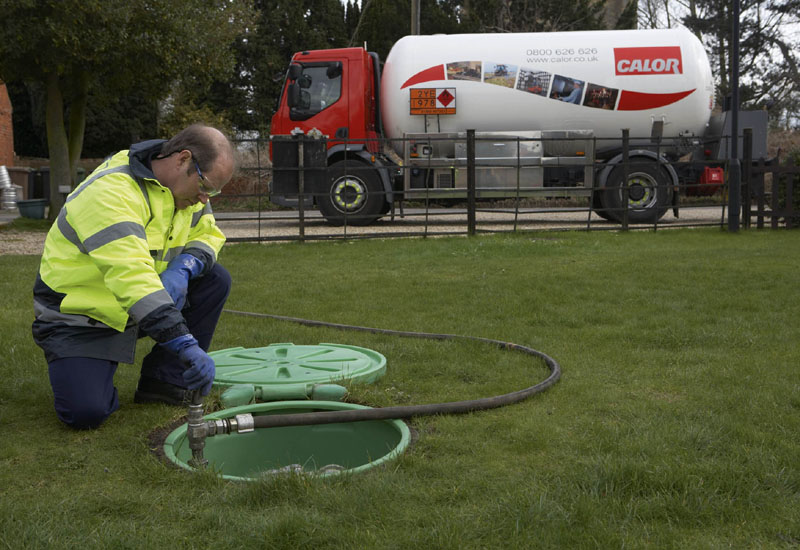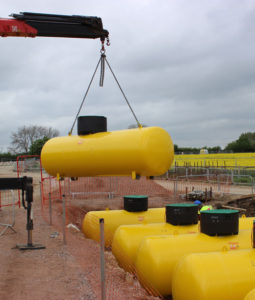
Ian Digby, Specifier Manager at Calor, explains why LPG offers an affordable and efficient solution for new housing developments built off the mains gas grid.
The National Grid reports gas delivers 321 TWh of energy to heat homes across the UK every year, to more than 23 million gas customers. Homeowners want a fuel that is affordable, secure and sustainable, and the reputation gas has as a familiar energy source – with a proven track record of providing heating and hot water to homes – means it is generally the preferred choice for many.
But for new housing developments constructed off-grid in rural areas, connecting to the mains gas grid may not be an option due to the high costs and waiting times involved.
In this scenario, oil-fired central heating systems have often been specified as the default alternative. However, these require a large oil tank to be installed in the rear garden of each property, which can be detrimental to the overall aesthetics of the house and a turn-off for many potential buyers.
Air source heat pump technology and electric storage heaters might also be considered, but the fact that many people are less familiar with these fuel sources can mean these are an unpopular choice too.
Furthermore, developers considering investing in renewable technologies should be aware that the larger radiators or hot water cylinders needed to support these can add significant additional build costs, as well as reducing living space for the occupier.
As a result, many housebuilders and property developers building off-grid are realising the numerous advantages of selecting LPG to power a new development.
 The benefits of LPG
The benefits of LPG
LPG can be installed as a communal system on a development, with the gas stored centrally in underground tanks and distributed through a network of pipes to the property in the same way as mains gas.
This approach creates a metered estate, with each resident billed separately for the gas consumed. The LPG supplier owns the central tanks, maintaining and refuelling automatically as necessary, without the need for individual gas tanks in the gardens of homeowners.
LPG boilers are the same size and have the same flue clearance as standard gas boilers, meaning there is no need to redesign standard property layouts to accommodate a larger, floor-standing oil boiler, for example. Service and maintenance costs are the same as a conventional gas boiler, reducing lifetime operating expense and running costs too.
As a result, not only are there significantly lower costs involved by not deviating from standard housing designs and layouts, the installation itself is much more aesthetically pleasing to future residents. What’s more, new homeowners receive all the benefits of gas for their home energy, including its versatility as a fuel for space heating, hot water and cooking.
 LPG in action
LPG in action
Kineton Meadows is a large, off-grid development in Warwickshire. Due to its size, there is a high demand for a reliable fuel source in order to accommodate the heating needs of its 105 homes.
Having investigated the cost of piping mains gas to the homes – which would be around a million pounds for every half-mile – Bloor Homes soon discounted this as a financially-viable option, and so had to go in search of an alternative fuel solution.
Geoff Hibbert, Engineering Manager at Bloor Homes Midlands, explains: “After reviewing alternative fuel options, it soon became clear that LPG was an ideal solution. Choosing LPG allowed us to build the house types and layout we had planned. If we had gone for any of the other alternative fuel options, such as oil, electricity or renewables, we would have had to significantly modify the layout of 105 homes, which would add to costs dramatically.”
By selecting LPG over oil developers can also take advantage of enhanced SAP ratings. Geoff Hibbert notes: “The SAPs ratings are also much better for a property fuelled by LPG in comparison to oil, meaning we don’t have to add any extra energy-saving features such as solar PV, triple glazing or significant extra insulation.”
Looking good
The aesthetic of the site was also a key consideration. Geoff says: “We really liked the idea of having a central storage location that would fuel all of the homes on the development, which meant that we didn’t have to excavate each garden to add individual tanks. Hiding the tanks underground was also a big selling point for us, as it meant there was no aesthetic impact on the site.”
LPG offers the rural developer the closest alternative to mains gas and significantly lower build costs than many other fuel options. It is also a proven and reliable technology, delivering peace of mind for the developer. For these reasons, LPG is being increasingly seen as the fuel of choice for off-grid developments.








